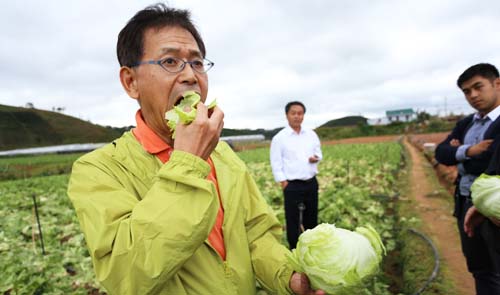Two Japanese farmers wish to bring their ‘enriching technology’ to Vietnam by setting up a ‘miraculous village’ in Da Lat.
‘Miraculous village’ is the nickname of Karakumi village in Japan, which was transformed from the poorest to the richest village after 20 years thanks to high-technology agriculture.
Notably, Karakumi, located in the west of Tokyo in Minamisaku District of Nagano Province, is the most barren locality in Japan. It can only support agricultural production for four months a year, from June to October. During the remaining months, it is covered in snow with freezing temperatures, reaching -20 degrees Celsius on the coldest days.
With only 1,735 hectares of agricultural land–a quarter of the farmland in Da Lat--the ‘miraculous village’ earns an annual income of US$150 million by sowing only American salad greens. Each household makes an average $250,000 a year despite working for only four months a year.
From Karakumi to Da Lat
In late November, two Japanese farmers, Masahito Shinohara, 34, and Takaya Hanaoka, 35, visited vegetable farms in Da Lat with agricultural experts and officials of the vegetable producing company An Phu Da Lat from the central highland province of Lam Dong.
The visit aimed at ‘multiplying technology to enrich’ Da Lat, which has a similar altitude to that of Karakumi, at 1,185m above sea level.
The plan to bring agricultural technology to Vietnam was initiated by Hironosi Tsuchiya, director of the investment fund HT Capital in Vietnam, after his visit to Da Lat in October. Proud of the ‘miraculous village,’ he suggested that young farmers of Karakumi expand its model to Da Lat, which has great potential thanks to its favorable growing conditions and fertile land.
The two Japanese farmers, owners of famous vegetable company Lacue, followed Tsuchiya to Da Lat with the motivation of expanding their business to Vietnam, because Karakumi has no more land to farm.
Scooping up a handful of soil at a vegetable farm in Lat Commune in Da Lat, Hanaoka crushed it in his fingers, smelled it, and said, “The most fertile plot of land in my village is possibly the worst here in Da Lat.”
He asked a local farmer for a cabbage and inspected every nook before eating it all, to the surprise of several local farmers looking on. He explained, “I understand the quality of the vegetable and the common method of production in this way.”
Hanaoka told a local farmer, “The current method of fertilization in Da Lat makes soil poorer in nutrients, contaminates clean vegetables, and degrades water quality.”
He added that he can transfer the farming technology of Karakumi to Da Lat, and told stories about farming in his homeland.

Masahito Shinohara (L) and Takaya Hanaoka are collecting soil samples in Da Lat (Photo: Tuoi Tre)
Karakumi was the poorest village of Japan until 1980 when a new head of the village was appointed and a new way of doing business was applied to create ‘a miracle’. The chief was Tadahiko Fujiwara, now 75.
The new way of farming in Karakumi is generally similar to the farming methods in Da Lat, but what differs is the unanimous decision of all farmers to abandon their old methods, said Shinohara.
Karakumi then had no GlobalGAP or any quality standards because the village chief told his locals simply, “what is used to fertilize vegetables must be friendly or edible to farmers,” according to Shinohara.
Discipline was strictly applied in Karakumi and quality standards became increasingly tightened.
Besides technology, discipline is Karakumi’s other key to earning US$150 million a year, he added.
Karakumi farmers also use a different method of collecting and keeping their vegetables than that of Vietnamese farmers. In Karakumi, vegetables are kept in air-conditioned containers that keep the temperature consistent after reaping, said Shinohara.
Karakumi students always return to their farming village to do business after graduating from agriculture schools.
Hanaoka, who has developed his two-hectare farm into a large company, produces 1,500 tons of American salad greens a year.
| Lacue is planning to start its business in Vietnam in 2014, after cooperating with farms in Da Lat to transfer their farming technology. In Karakumi, farmers have a television channel to provide information on the prices of agricultural products so they can adjust the time at which they reap their crops. |

Takaya Hanaoka joins collecting vegetables in Da Lat to understand its quality (Photo: Tuoi Tre)





















































